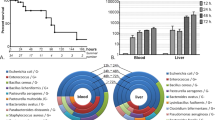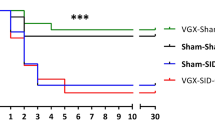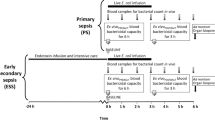Abstract
Sepsis remains a prevalent clinical challenge and the underlying pathophysiology is still poorly understood. To investigate the complex molecular mechanisms of sepsis, various animal models have been developed, the most frequently used being the cecal ligation and puncture (CLP) model in rodents. In this model, sepsis originates from a polymicrobial infectious focus within the abdominal cavity, followed by bacterial translocation into the blood compartment, which then triggers a systemic inflammatory response. A requirement of this model is that it is performed with high consistency to obtain reproducible results. Evidence is now emerging that the accompanying inflammatory response varies with the severity grade of sepsis, which is highly dependent on the extent of cecal ligation. In this protocol, we define standardized procedures for inducing sepsis in mice and rats by applying defined severity grades of sepsis through modulation of the position of cecal ligation. The CLP procedure can be performed in as little as 10 min for each animal by an experienced user, with additional time required for subsequent postoperative care and data collection.
This is a preview of subscription content, access via your institution
Access options
Subscribe to this journal
Receive 12 print issues and online access
$259.00 per year
only $21.58 per issue
Buy this article
- Purchase on Springer Link
- Instant access to full article PDF
Prices may be subject to local taxes which are calculated during checkout



Similar content being viewed by others
References
Dombrovskiy, V.Y., Martin, A.A., Sunderram, J. & Paz, H.L. Rapid increase in hospitalization and mortality rates for severe sepsis in the United States: a trend analysis from 1993 to 2003. Crit. Care. Med. 35, 1244–1250 (2007).
Kochanek, K.D. & Smith, B.L. Deaths: preliminary data for 2002. Natl. Vital. Stat. Rep. 52, 1–47 (2004).
Rittirsch, D., Hoesel, L.M. & Ward, P.A. The disconnect between animal models of sepsis and human sepsis. J. Leukoc. Biol. 81, 137–143 (2007).
Remick, D.G., Newcomb, D.E., Bolgos, G.L. & Call, D.R. Comparison of the mortality and inflammatory response of two models of sepsis: lipopolysaccharide vs. cecal ligation and puncture. Shock 13, 110–116 (2000).
Deitch, E.A. Rodent models of intra-abdominal infection. Shock 24 (Suppl. 1): 19–23 (2005).
Buras, J.A., Holzmann, B. & Sitkovsky, M. Animal models of sepsis: setting the stage. Nat. Rev. Drug Discov. 4, 854–865 (2005).
Wichterman, K.A., Baue, A.E. & Chaudry, I.H. Sepsis and septic shock—a review of laboratory models and a proposal. J. Surg. Res. 29, 189–201 (1980).
Hubbard, W.J. et al. Cecal ligation and puncture. Shock 24 (Suppl 1): 52–57 (2005).
Benjamim, C.F., Hogaboam, C.M. & Kunkel, S.L. The chronic consequences of severe sepsis. J. Leukoc. Biol. 75, 408–412 (2004).
Xiao, H., Siddiqui, J. & Remick, D.G. Mechanisms of mortality in early and late sepsis. Infect. Immun. 74, 5227–5235 (2006).
Singleton, K.D. & Wischmeyer, P.E. Distance of cecum ligated influences mortality, tumor necrosis factor-alpha and interleukin-6 expression following cecal ligation and puncture in the rat. Eur. Surg. Res. 35, 486–491 (2003).
Baker, C.C., Chaudry, I.H., Gaines, H.O. & Baue, A.E. Evaluation of factors affecting mortality rate after sepsis in a murine cecal ligation and puncture model. Surgery 94, 331–335 (1983).
Rittirsch, D. et al. Functional roles for C5a receptors in sepsis. Nat. Med. 14, 551–557 (2008).
Wichterman, K.A., Baue, A.E. & Chaudry, I.H. Sepsis and septic shock—a review of laboratory models and a proposal. J. Surg. Res. 29, 189–201 (1980).
Heuer, J.G. et al. Cecal ligation puncture with total parenteral nutrition: a clinically relevant model of the metabolic, hormonal, and inflammatory dysfunction associated with critical illness. J. Surg. Res. 121, 178–186 (2004).
Smith, E.F. III, et al. Fluid resuscitation improves survival of endotoxemic or septicemic rats: possible contribution of tumor necrosis factor. Pharmacology 46, 254–267 (1993).
Law, M. & Remick, D. Fluid resuscitation and antibiotics enhance survival by unknown mechanisms. Shock 25, 6 (2006).
Xiao, H., Siddiqui, J. & Remick, D.G. Mechanisms of mortality in early and late sepsis. Infect. Immun. 74, 5227–5235 (2006).
Latifi, S.Q., O'Riordan, M.A. & Levine, A.D. Interleukin-10 controls the onset of irreversible septic shock. Infect. Immun. 70, 4441–4446 (2002).
Coria-Avila, G.A., Gavrila, A.M., Menard, S., Ismail, N. & Pfaus, J.G. Cecum location in rats and the implications for intraperitoneal injections. Lab. Anim. (NY) 36, 25–30 (2007).
Godshall, C.J., Scott, M.J., Peyton, J.C., Gardner, S.A. & Cheadle, W.G. Genetic background determines susceptibility during murine septic peritonitis. J. Surg. Res. 102, 45–49 (2002).
Hollenberg, S.M., et al. Characterization of a hyperdynamic murine model of resuscitated sepsis using echocardiography. Am. J. Respir. Crit. Care Med. 164, 891–895 (2001).
Newcomb, D., Bolgos, G., Green, L. & Remick, D.G. Antibiotic treatment influences outcome in murine sepsis: mediators of increased morbidity. Shock 10, 110–117 (1998).
Flierl, M.A. et al. Adverse functions of IL-17A in experimental sepsis. FASEB J. 22, 2198–2205. Epub 2008 Feb 25.
Acknowledgements
This work was supported by NIH grants GM-61656, GM-029507 and HL-31963 (to P.A.W.).
Author information
Authors and Affiliations
Corresponding author
Rights and permissions
About this article
Cite this article
Rittirsch, D., Huber-Lang, M., Flierl, M. et al. Immunodesign of experimental sepsis by cecal ligation and puncture. Nat Protoc 4, 31–36 (2009). https://doi.org/10.1038/nprot.2008.214
Published:
Issue Date:
DOI: https://doi.org/10.1038/nprot.2008.214
This article is cited by
-
Pharmacologically significant constituents collectively responsible for anti-sepsis action of XueBiJing, a Chinese herb-based intravenous formulation
Acta Pharmacologica Sinica (2024)
-
ACE2 Expressed on Myeloid Cells Alleviates Sepsis-Induced Acute Liver Injury via the Ang-(1–7)–Mas Receptor Axis
Inflammation (2024)
-
Erbin accelerates TFEB-mediated lysosome biogenesis and autophagy and alleviates sepsis-induced inflammatory responses and organ injuries
Journal of Translational Medicine (2023)
-
Pericytes protect rats and mice from sepsis-induced injuries by maintaining vascular reactivity and barrier function: implication of miRNAs and microvesicles
Military Medical Research (2023)
-
Dose-specific efficacy of adipose-derived mesenchymal stem cells in septic mice
Stem Cell Research & Therapy (2023)
Comments
By submitting a comment you agree to abide by our Terms and Community Guidelines. If you find something abusive or that does not comply with our terms or guidelines please flag it as inappropriate.



